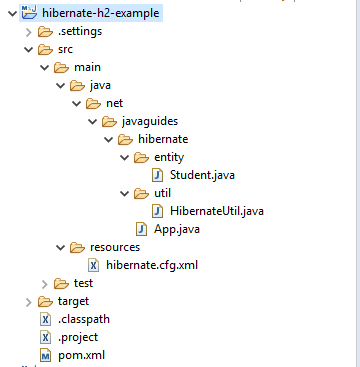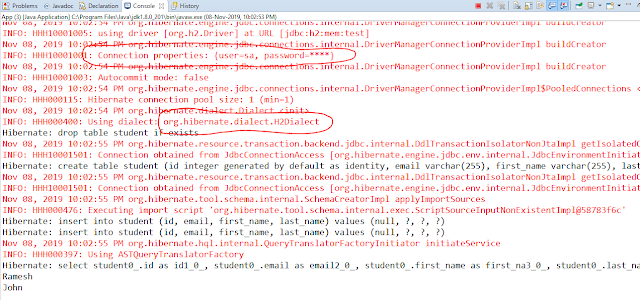In this example, you will learn how to create a Hibernate Application to connect the H2 in-memory database.
Hibernate is an object-relational mapping framework for the Java language. It provides a framework for mapping an object-oriented domain model to a relational database. Object-relational mapping (ORM) is a programming technique for converting data between incompatible type systems in object-oriented programming languages.
H2 is an open-source lightweight Java database. It can be embedded in Java applications or run in the client-server mode.
Hibernate is an object-relational mapping framework for the Java language. It provides a framework for mapping an object-oriented domain model to a relational database. Object-relational mapping (ORM) is a programming technique for converting data between incompatible type systems in object-oriented programming languages.
H2 is an open-source lightweight Java database. It can be embedded in Java applications or run in the client-server mode.
Hibernate H2 In-Memory Embedded Database Example
Let's start developing step by step Hibernate application using Maven as project management and build tool.Technologies and tools used
- Hibernate 5.3.7.Final
- IDE - Eclipse Noen
- Maven 3.5.3
- JavaSE 1.8
- H2 In-Memory - 1.4.200
Development Steps
- Create a Simple Maven Project
- Project Directory Structure
- Add jar Dependencies to pom.xml
- Creating the JPA Entity Class(Persistent class)
- Create a Hibernate configuration file - hibernate.cfg.xml
- Create a Hibernate utility class
- Create the Main class and Run an Application
1. Create a Simple Maven Project
Use How to Create a Simple Maven Project in Eclipse article to create a simple Maven project in Eclipse IDE.
2. Project Directory Structure
3. Add jar Dependencies to pom.xml
Let's add h2 database and hibernate-core dependency to pom.xml:
<project xmlns="http://maven.apache.org/POM/4.0.0" xmlns:xsi="http://www.w3.org/2001/XMLSchema-instance" xsi:schemaLocation="http://maven.apache.org/POM/4.0.0 http://maven.apache.org/xsd/maven-4.0.0.xsd"> <modelVersion>4.0.0</modelVersion> <groupId>net.javaguides</groupId> <artifactId>hibernate-helloworld-example</artifactId> <version>0.0.1-SNAPSHOT</version> <name>hibernate-helloworld-example</name> <description>hibernate-helloworld-example</description> <dependencies> <!-- https://mvnrepository.com/artifact/com.h2database/h2 --> <dependency> <groupId>com.h2database</groupId> <artifactId>h2</artifactId> <version>1.4.200</version> </dependency> <!-- https://mvnrepository.com/artifact/org.hibernate/hibernate-core --> <dependency> <groupId>org.hibernate</groupId> <artifactId>hibernate-core</artifactId> <version>5.3.7.Final</version> </dependency> </dependencies> <build> <sourceDirectory>src/main/java</sourceDirectory> <plugins> <plugin> <artifactId>maven-compiler-plugin</artifactId> <version>3.5.1</version> <configuration> <source>1.8</source> <target>1.8</target> </configuration> </plugin> </plugins> </build> </project>
4. Creating the JPA Entity Class(Persistent class)
Let's create a Student persistent class that is mapped to a database "student" table.
A simple persistent class should follow some rules:
- A no-arg constructor: It is recommended that you have a default constructor at least package visibility so that hibernate can create the instance of the Persistent class by newInstance() method.
- Provide an identifier property: It is better to assign an attribute as id. This attribute behaves as a primary key in a database.
- Declare getter and setter methods: The Hibernate recognizes the method by getter and setter method names by default.
- Prefer non-final class: Hibernate uses the concept of proxies, which depends on the persistent class. The application programmer will not be able to use proxies for lazy association fetching.
Create a Student entity class under net.javaguides.hibernate.entity package as follows.
package net.javaguides.hibernate.entity;
import javax.persistence.Column;
import javax.persistence.Entity;
import javax.persistence.GeneratedValue;
import javax.persistence.GenerationType;
import javax.persistence.Id;
import javax.persistence.Table;
@Entity
@Table(name = "student")
public class Student {
@Id
@GeneratedValue(strategy = GenerationType.IDENTITY)
@Column(name = "id")
private int id;
@Column(name = "first_name")
private String firstName;
@Column(name = "last_name")
private String lastName;
@Column(name = "email")
private String email;
public Student() {
}
public Student(String firstName, String lastName, String email) {
this.firstName = firstName;
this.lastName = lastName;
this.email = email;
}
public int getId() {
return id;
}
public void setId(int id) {
this.id = id;
}
public String getFirstName() {
return firstName;
}
public void setFirstName(String firstName) {
this.firstName = firstName;
}
public String getLastName() {
return lastName;
}
public void setLastName(String lastName) {
this.lastName = lastName;
}
public String getEmail() {
return email;
}
public void setEmail(String email) {
this.email = email;
}
@Override
public String toString() {
return "Student [id=" + id + ", firstName=" + firstName + ", lastName=" + lastName + ", email=" + email + "]";
}
}
5. Create a Hibernate configuration file - hibernate.cfg.xml
The configuration file contains information about the database and mapping file. Conventionally, its name should be hibernate.cfg.xml.
Let's create an XML file named hibernate.cfg.xml under the resources folder and write the following code in it.
<!DOCTYPE hibernate-configuration PUBLIC "-//Hibernate/Hibernate Configuration DTD 3.0//EN" "http://www.hibernate.org/dtd/hibernate-configuration-3.0.dtd"> <hibernate-configuration> <session-factory> <!-- JDBC Database connection settings --> <property name="connection.driver_class">org.h2.Driver</property> <property name="connection.url">jdbc:h2:mem:test</property> <property name="connection.username">sa</property> <property name="connection.password"></property> <!-- JDBC connection pool settings ... using built-in test pool --> <property name="connection.pool_size">1</property> <!-- Select our SQL dialect --> <property name="dialect">org.hibernate.dialect.H2Dialect</property> <!-- Echo the SQL to stdout --> <property name="show_sql">true</property> <!-- Set the current session context --> <property name="current_session_context_class">thread</property> <!-- Drop and re-create the database schema on startup --> <property name="hbm2ddl.auto">create-drop</property> <!-- dbcp connection pool configuration --> <property name="hibernate.dbcp.initialSize">5</property> <property name="hibernate.dbcp.maxTotal">20</property> <property name="hibernate.dbcp.maxIdle">10</property> <property name="hibernate.dbcp.minIdle">5</property> <property name="hibernate.dbcp.maxWaitMillis">-1</property> <mapping class="net.javaguides.hibernate.entity.Student" /> </session-factory> </hibernate-configuration>
In the above configuration, notice that Hibernate dialect for the h2 database(org.hibernate.dialect.H2Dialect). By default the Java application to connect to an H2 in-memory store with the username sa and an empty password.
6. Create a Hibernate utility Class
Create a helper class to bootstrap hibernate SessionFactory. In most Hibernate applications, the SessionFactory should be instantiated once during application initialization. The single instance should then be used by all code in a particular process, and any Session should be created using this single SessionFactory.
The SessionFactory is thread-safe and can be shared; a Session is a single-threaded object. Let's create a HibernateUtil class to configure singleton SessionFactory and use it throughout the application.
The SessionFactory is thread-safe and can be shared; a Session is a single-threaded object. Let's create a HibernateUtil class to configure singleton SessionFactory and use it throughout the application.
The bootstrapping API is quite flexible, but in most cases, it makes the most sense to think of it as a 3 step process:
- Build the StandardServiceRegistry
- Build the Metadata
- Use those 2 to build the SessionFactory
package net.javaguides.hibernate.util;
import org.hibernate.SessionFactory;
import org.hibernate.boot.Metadata;
import org.hibernate.boot.MetadataSources;
import org.hibernate.boot.registry.StandardServiceRegistry;
import org.hibernate.boot.registry.StandardServiceRegistryBuilder;
public class HibernateUtil {
private static StandardServiceRegistry registry;
private static SessionFactory sessionFactory;
public static SessionFactory getSessionFactory() {
if (sessionFactory == null) {
try {
// Create registry
registry = new StandardServiceRegistryBuilder().configure().build();
// Create MetadataSources
MetadataSources sources = new MetadataSources(registry);
// Create Metadata
Metadata metadata = sources.getMetadataBuilder().build();
// Create SessionFactory
sessionFactory = metadata.getSessionFactoryBuilder().build();
} catch (Exception e) {
e.printStackTrace();
if (registry != null) {
StandardServiceRegistryBuilder.destroy(registry);
}
}
}
return sessionFactory;
}
public static void shutdown() {
if (registry != null) {
StandardServiceRegistryBuilder.destroy(registry);
}
}
}
7. Create the main App class and Run an Application
Here is the main App class which is used to connect the H2 database and persist Student object in database table.
package net.javaguides.hibernate;
import java.util.List;
import org.hibernate.Session;
import org.hibernate.Transaction;
import net.javaguides.hibernate.entity.Student;
import net.javaguides.hibernate.util.HibernateUtil;
public class App {
public static void main(String[] args) {
Student student = new Student("Ramesh", "Fadatare", "rameshfadatare@javaguides.com");
Student student1 = new Student("John", "Cena", "john@javaguides.com");
Transaction transaction = null;
try (Session session = HibernateUtil.getSessionFactory().openSession()) {
// start a transaction
transaction = session.beginTransaction();
// save the student objects
session.save(student);
session.save(student1);
// commit transaction
transaction.commit();
} catch (Exception e) {
if (transaction != null) {
transaction.rollback();
}
e.printStackTrace();
}
try (Session session = HibernateUtil.getSessionFactory().openSession()) {
List < Student > students = session.createQuery("from Student", Student.class).list();
students.forEach(s - > System.out.println(s.getFirstName()));
} catch (Exception e) {
if (transaction != null) {
transaction.rollback();
}
e.printStackTrace();
}
}
}
Output
Eclipse
H2
Hibernate Framework
Java
Maven



Comments
Post a Comment